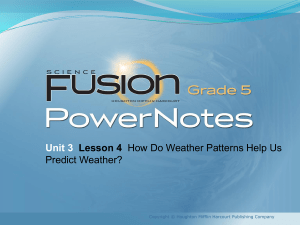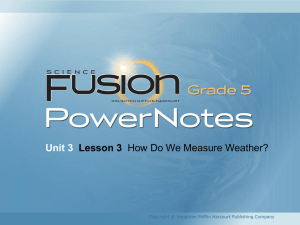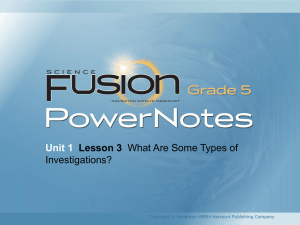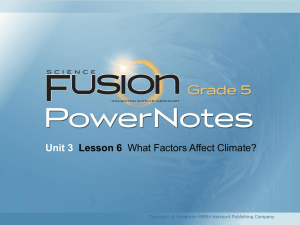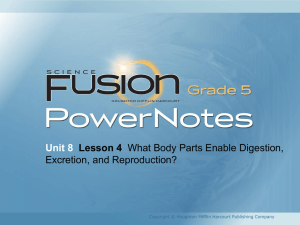Lesson 1
advertisement
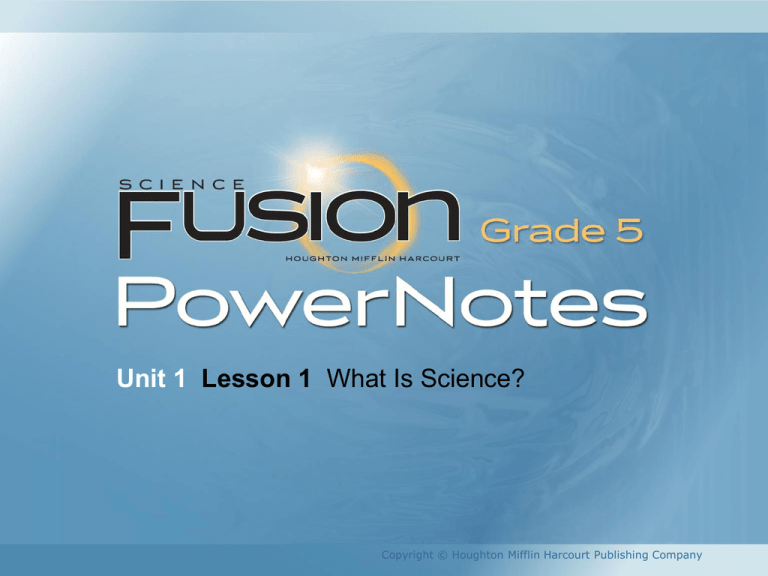
Unit 1 Lesson 1 What Is Science? Copyright © Houghton Mifflin Harcourt Publishing Company Unit 1 Lesson 1 What Is Science? Florida Benchmarks • SC.5.N.1.6 Recognize and explain the difference between personal opinion/interpretation and verified observation. • SC.5.N.2.1 Recognize and explain that science is grounded in empirical observations that are testable; explanation must always be linked with evidence. • SC.5.N.2.2 Recognize and explain that when scientific investigations are carried out, the evidence produced by those investigations should be replicable by others. Copyright © Houghton Mifflin Harcourt Publishing Company Unit 1 Lesson 1 What Is Science? What All Scientists Do • Scientists use investigations to try to explain how and why things in the natural world work. • Investigations are procedures carried out to observe, study, or test something. • Science is the study of the natural world through careful observation and investigation. There are many branches of science. Copyright © Houghton Mifflin Harcourt Publishing Company Unit 1 Lesson 1 What Is Science? What All Scientists Do • All scientists observe by using their five senses to collect information. • All scientists compare by finding ways objects and events are similar and different. • Scientists must think critically about the results of their investigations to learn more about the natural world. Copyright © Houghton Mifflin Harcourt Publishing Company Unit 1 Lesson 1 What Is Science? Prove It! • Scientists collect evidence, or information, during a scientific investigation. • Evidence can be direct. A fossil of a dinosaur skull is direct evidence that dinosaurs once lived. • Evidence can be indirect. A fossil of a dinosaur footprint is indirect evidence of dinosaurs. Copyright © Houghton Mifflin Harcourt Publishing Company Unit 1 Lesson 1 What Is Science? Prove It! • Here is an example of a scientist collecting evidence. • In the 1660s, a scientist named Dr. Francesco Redi designed an experiment on maggots. • At that time, most people thought maggots grew out of rotting meat. Copyright © Houghton Mifflin Harcourt Publishing Company Unit 1 Lesson 1 What Is Science? Prove It! • Redi put fresh meat in two jars. He covered one jar with cloth. Copyright © Houghton Mifflin Harcourt Publishing Company Unit 1 Lesson 1 What Is Science? Prove It! • He observed the meat over many days. • He saw that flies landed on the meat in the uncovered jar. No flies landed on the meat in the other jar. Copyright © Houghton Mifflin Harcourt Publishing Company Unit 1 Lesson 1 What Is Science? Prove It! • Soon, there were maggots on the meat in the uncovered jar. There were no maggots on the meat in the covered jar. Copyright © Houghton Mifflin Harcourt Publishing Company Unit 1 Lesson 1 What Is Science? Prove It! • Redi repeated the experiment many times. • Each time, he observed the same thing: Maggots grew on meat that flies landed on, but no maggots appeared on meat with no flies. • He concluded that maggots come from eggs that flies lay. Copyright © Houghton Mifflin Harcourt Publishing Company Unit 1 Lesson 1 What Is Science? Prove It! • Which jar would the meat in the image below have been in? Copyright © Houghton Mifflin Harcourt Publishing Company Unit 1 Lesson 1 What Is Science? A Sticky Trap How to Draw Conclusions • Scientists repeat investigations over and over to draw conclusions. The conclusions are always based on evidence. • A scientist uses inferences to draw conclusions based on evidence. • Scientists do not use feelings or favorites to draw conclusions. Copyright © Houghton Mifflin Harcourt Publishing Company Unit 1 Lesson 1 What Is Science? Opinion or Evidence? • Opinions are beliefs or judgments. Scientists do not use opinions to draw conclusions. • Personal feelings and opinions should not affect how you do investigations. • You should not ignore evidence, even if you do not like what it means. Copyright © Houghton Mifflin Harcourt Publishing Company Unit 1 Lesson 1 What Is Science? Knowledge Grows • Scientists communicate, or share, the results of investigations. • Other scientists can repeat the investigations and compare the results. • Scientific knowledge grows as scientists expand on one another’s ideas. Copyright © Houghton Mifflin Harcourt Publishing Company Unit 1 Lesson 1 What Is Science? Meet Scientists • Many people work as many different types of scientists. • Examples of scientists include astronomers, botanists, and taxonomists. Copyright © Houghton Mifflin Harcourt Publishing Company Unit 1 Lesson 1 What Is Science? Meet Scientists • Scientists may need to place objects or events in order. They may also need to classify objects or events based on specific characteristics. • How do you know the order, or correct sequence, for the images below? Copyright © Houghton Mifflin Harcourt Publishing Company




